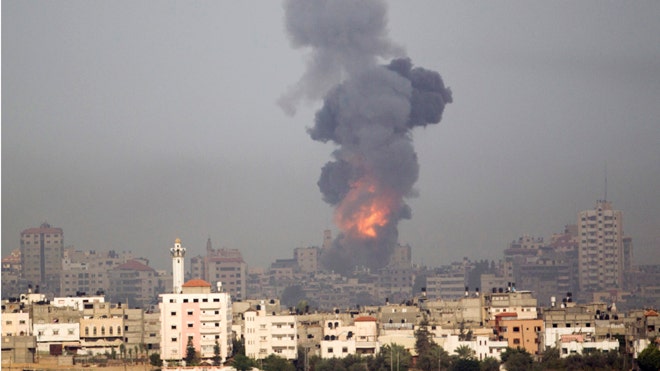
HAIFA, Israel – Hundreds of Iranian-made, long-range missiles already smuggled into Gaza provided a secret sense of urgency behind Israel’s recent campaign against Hamas, and the the Jewish state acted with the Obama administration’s full knowledge, intelligence experts told FoxNews.com.
Jonathan Schantzer, a former counter-terrorism analyst at the U.S. Department of the Treasury, said the real agenda behind Israel’s assault last month on Hamas’ munitions stockpiles and smuggling tunnels was not simply to end the daily barrage of relatively primitive rockets that have become part of daily life in Israel. The real mission was to eliminate as many as 100 Iranian-built Fajr5 missiles – with the power to reach Tel Aviv – that had been sneaked into Gaza through Egypt. The Obama administration knew in advance of the operation and agreed that the missiles, built in a Sudanese factory, had to be neutralized to protect millions of Israeli citizens who were now within range of the deadly Iranian weapons, according to Schantzer.
“The U.S. was fully aware of what was going to come in Gaza,” Schantzer, now vice president of research at the Foundation for the Defense of Democracies, told FoxNews.com. “They said nothing for the first few days of the operation; there was dead silence from [Obama].”
Israel essentially achieved its main aims within the first few days, said Schantzer, noting that Michael Oren, Israel’s ambassador to the U.S., said as much when he remarked on Day Three of the campaign: “We have run out of good targets.”
 Rocket attacks from Gaza were commonplace in Israel prior to the campaign, dubbed “Operation Pillar of Defense,” with at least 750 projectiles falling on the area close to the border since January. The attacks were ratcheted up in early November, which seemed to prompt Israel’s move and the deployment of its vaunted “Iron Dome” defense system. But behind the scenes, the Israel Defense Force (IDF) had a more pressing need to launch their intense bombardment on Hamas’ weapons stores.
Rocket attacks from Gaza were commonplace in Israel prior to the campaign, dubbed “Operation Pillar of Defense,” with at least 750 projectiles falling on the area close to the border since January. The attacks were ratcheted up in early November, which seemed to prompt Israel’s move and the deployment of its vaunted “Iron Dome” defense system. But behind the scenes, the Israel Defense Force (IDF) had a more pressing need to launch their intense bombardment on Hamas’ weapons stores.
Israel’s elimination of senior Hamas figure Ahmad Jabari as he drove in broad daylight in Gaza also fits into Schantzer’s narrative.
“Ahmad Jabari, along with another major Hamas figure, Mahmoud al Mabhouhk, [who was assassinated in Dubai in 2010], was a key part of the procurement network for the Fajr missiles and there is little doubt that Israel was keen to take out the man responsible,” Schantzer explained.
Schantzer contends that the operation actually began three weeks earlier, when, on Oct. 23, the Iranian-owned Yarmouk armaments factory in Sudan – believed to be the assembly plant for the Fajr5 missiles that have a range of up to 45 miles – was devastated by air strikes for which the Sudanese government holds Israel responsible. Israel, and for that matter the U.S., both deny any knowledge of the attack.
Sudanese Information Minister Ahmad Bilal Osman, told Al Jazeera the day after the attack, “Israel has accused Sudan of sending arms to Hamas. These allegations are not correct. The factory manufactures ordinary, legal weapons.”
When asked how Sudan would respond to the incident, Osman answered, “We definitely won’t attack Israel itself…but we have a right to tackle the interests of Israel wherever they are from now on.”
It may not have been coincidental that the destruction of the Sudanese factory occurred at exactly the same time that a joint Israeli/U.S. military exercise, ‘Austere Challenge’, involving some 3,500 U.S. troops, was taking place in Israel. Some military analysts have suggested that the exercises and the Gaza operation were part of a dry run for a potential future incursion into Iran.
Fox News has the full article









